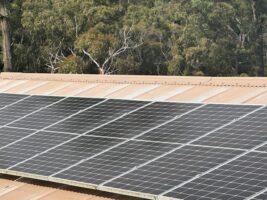So much for a smart grid. Or a cheaper one. The technology troglodytes on conservative media have taken less than 24 hours to have a collective meltdown over “demand response” – a new initiative to encourage consumers, particularly industry, to shift their loads to help manage demand peaks and moderate prices.
Demand response is a tool used widely in the US, Asia, Europe, New Zealand and even in Western Australia to employ a cheaper, smarter, and cleaner tool than switching on a fossil fuel generator in response to peaks in demand. It’s got nothing to do with wind and solar, or the lack of it.
Don’t tell that to conservatives. Like renewables and battery storage before it, demand response commits the crime of causing less coal and gas to be burned. And that’s just too awful a scenario for the conservative commentariat to contemplate.
Every week one is tempted to think that the debate can not get any dumber. This week though, we’ve had the AFR hit rock bottom on battery storage, and Tony Abbott evoking the flat Earthers on climate change. It’s not crap, it turns out, it’s actually really good for us.
And so, the conservatives were quick to confect misleading outrage when it was announced on Wednesday that a portfolio of 200MW of demand response, acting as a “virtual power plant” had been put together by the Australian Energy Market Operator and the Australian Renewable Energy Agency.
And their principal claim – that it was an attack on the poor that would force vulnerable people to turn off their air conditioning – hit peak stupid in less than 24 hours.
“It’s humiliating … it’s demeaning to people. Kids will go round to the next door neighbour’s house on a really hot day (because) the air conditioning isn’t on. It’s the poor people who are being bribed by the government,” said Rowan Dean, a columnist for the Murdoch tabloids and a talking head on Sky News.
Andrew Bolt agreed: “And remember: none of this will cut the world’s temperature. It’s all for nothing,” he proclaimed. Alan Jones was picking up the same thread on 2GB on Thursday morning.
Chris Kenny, another Murdoch columnist and TV talking head, launched into this extraordinary attack on Sky News:
“We are now looking at paying households taxpayers’ money to not use the electricity when they most need it. We will pay people to switch them off. A first world country – it is a bad as that. It is as absurd as that.
“Demand management is bullshit. It is political speak for supply stuff-up.”
Like Bolt, Kenny blamed the entire thing on renewable energy, repeating Bolt’s claims almost word for word. “We are subsiding renewable energy, and because of that we don’t have enough energy now we are going to pay us more to not use it.”
Jane Marwick a Sky News conributor based in Perth, claimed that at least things were OK on the other side of the Nullabor plane, because they are not part of the national electricity market.
Sorry to break the news to you, but W.A. has long had the only advance demand response market in Australia, long before any renewables were brought to the state.
“What concerns me when I see it – it’s going to be the elederly will take it really really seriously, she said. It’s Going to send wrong message to all wrong people. It is a disaster.”
This absurd argument was then repeated and enlarged upon by a Fairfax columnist, Mark Kenny (Chris Kenny’s cousin), a normally sane commentator who must have felt the need to conform when on Sky:
“It is encouraging people not to turn on air conditioning – it will be old people who are most vulnerable – it will be terrible thing to have people at that stage of their life making that decision because they feel they have to.”
So what was the source of their outrage? On Wednesday, the federal government, AEMO and ARENA unveiled the winners of its demand response tender, a group for 10 projects focusing mostly on industrial and commercial loads, but also tapping into consumers.
It is entirely voluntary, and in the case of households will mostly comprise using the load from battery storage, and shifting the timing of loads such as heat pumps and hot water.
Powershop CEO Ed McManus says its entirely up to the customer, and in a recent survey tens of thousands of its customers had indicated their interest. “These are small things that don’t impact their life … even with air conditioners only minor changes were involved and consumers can choose to participate or not.”
And this way, consumers get paid, unlike the informal request last summer when the NSW asked consumers to dial back their energy use, and a warning from coal-dependent Queensland that they may be asked to do the same this summer.
Audrey Zibelman, the CEO of AEMO, made it clear that the demand response program was “absolutely” not about “turning the lights off or making people uncomfortable”.
“It is not about turning the lights off or making people uncomfortable, it is actually just getting smarter about using [electricity], just like we got smarter about using water, and therefore making it efficient and cheaper.”
In the PJM, one of the biggest energy markets in America, demand response was introduced well before any wind or solar was added to the grid, because it is a cheaper way of managing supply and demand than simply burning more coal or gas when a lot of people want to use electricity at the same time.
Ditto in Western Australia (although that scheme was badly managed). But well run, demand response is merely an incentive to encourage people who don’t need to use electricity at a particular time to shift their use for an hour or two. It saves everyone money. No one is forced to do anything.
In Australia, consumers have actually been doing this for decades, ever since the introduction of controlled load for hot water systems, when the water heating was switched on at night to give coal generators something to do.
But what’s good for the consumer in the era of coal is clearly not good for the consumer in the era of renewables.











